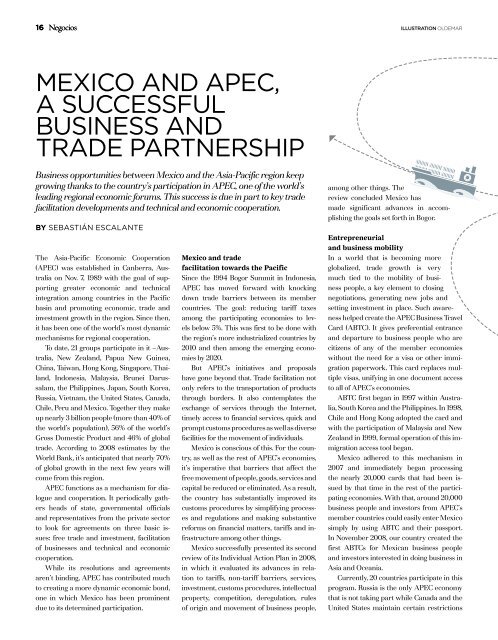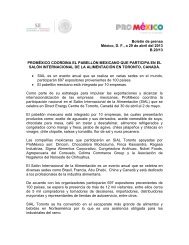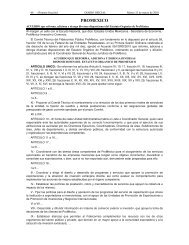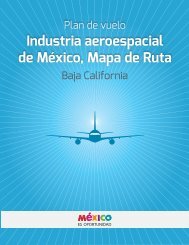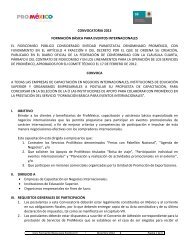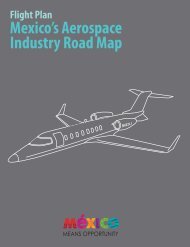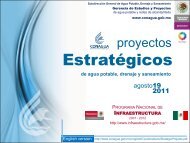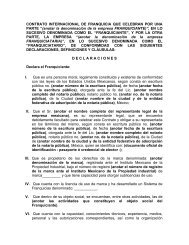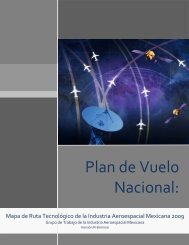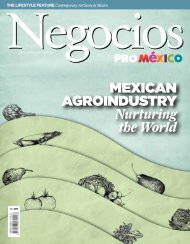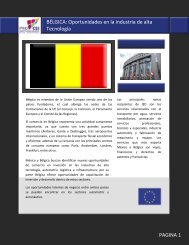ASiAn invASion wElcomEd - ProMéxico
ASiAn invASion wElcomEd - ProMéxico
ASiAn invASion wElcomEd - ProMéxico
Create successful ePaper yourself
Turn your PDF publications into a flip-book with our unique Google optimized e-Paper software.
16 Negocios illustration oldemar<br />
Mexico and APEC,<br />
A Successful<br />
Business and<br />
Trade Partnership<br />
Business opportunities between Mexico and the Asia-Pacific region keep<br />
growing thanks to the country’s participation in APEC, one of the world’s<br />
leading regional economic forums. This success is due in part to key trade<br />
facilitation developments and technical and economic cooperation.<br />
By Sebastián Escalante<br />
The Asia-Pacific Economic Cooperation<br />
(APEC) was established in Canberra, Australia<br />
on Nov. 7, 1989 with the goal of supporting<br />
greater economic and technical<br />
integration among countries in the Pacific<br />
basin and promoting economic, trade and<br />
investment growth in the region. Since then,<br />
it has been one of the world’s most dynamic<br />
mechanisms for regional cooperation.<br />
To date, 21 groups participate in it –Australia,<br />
New Zealand, Papua New Guinea,<br />
China, Taiwan, Hong Kong, Singapore, Thailand,<br />
Indonesia, Malaysia, Brunei Darussalam,<br />
the Philippines, Japan, South Korea,<br />
Russia, Vietnam, the United States, Canada,<br />
Chile, Peru and Mexico. Together they make<br />
up nearly 3 billion people (more than 40% of<br />
the world’s population), 56% of the world’s<br />
Gross Domestic Product and 46% of global<br />
trade. According to 2008 estimates by the<br />
World Bank, it’s anticipated that nearly 70%<br />
of global growth in the next few years will<br />
come from this region.<br />
APEC functions as a mechanism for dialogue<br />
and cooperation. It periodically gathers<br />
heads of state, governmental officials<br />
and representatives from the private sector<br />
to look for agreements on three basic issues:<br />
free trade and investment, facilitation<br />
of businesses and technical and economic<br />
cooperation.<br />
While its resolutions and agreements<br />
aren’t binding, APEC has contributed much<br />
to creating a more dynamic economic bond,<br />
one in which Mexico has been prominent<br />
due to its determined participation.<br />
Mexico and trade<br />
facilitation towards the Pacific<br />
Since the 1994 Bogor Summit in Indonesia,<br />
APEC has moved forward with knocking<br />
down trade barriers between its member<br />
countries. The goal: reducing tariff taxes<br />
among the participating economies to levels<br />
below 5%. This was first to be done with<br />
the region’s more industrialized countries by<br />
2010 and then among the emerging economies<br />
by 2020.<br />
But APEC’s initiatives and proposals<br />
have gone beyond that. Trade facilitation not<br />
only refers to the transportation of products<br />
through borders. It also contemplates the<br />
exchange of services through the Internet,<br />
timely access to financial services, quick and<br />
prompt customs procedures as well as diverse<br />
facilities for the movement of individuals.<br />
Mexico is conscious of this. For the country,<br />
as well as the rest of APEC’s economies,<br />
it’s imperative that barriers that affect the<br />
free movement of people, goods, services and<br />
capital be reduced or eliminated. As a result,<br />
the country has substantially improved its<br />
customs procedures by simplifying processes<br />
and regulations and making substantive<br />
reforms on financial matters, tariffs and infrastructure<br />
among other things.<br />
Mexico successfully presented its second<br />
review of its Individual Action Plan in 2008,<br />
in which it evaluated its advances in relation<br />
to tariffs, non-tariff barriers, services,<br />
investment, customs procedures, intellectual<br />
property, competition, deregulation, rules<br />
of origin and movement of business people,<br />
among other things. The<br />
review concluded Mexico has<br />
made significant advances in accomplishing<br />
the goals set forth in Bogor.<br />
Entrepreneurial<br />
and business mobility<br />
In a world that is becoming more<br />
globalized, trade growth is very<br />
much tied to the mobility of business<br />
people, a key element to closing<br />
negotiations, generating new jobs and<br />
setting investment in place. Such awareness<br />
helped create the APEC Business Travel<br />
Card (ABTC). It gives preferential entrance<br />
and departure to business people who are<br />
citizens of any of the member economies<br />
without the need for a visa or other immigration<br />
paperwork. This card replaces multiple<br />
visas, unifying in one document access<br />
to all of APEC’s economies.<br />
ABTC first began in 1997 within Australia,<br />
South Korea and the Philippines. In 1998,<br />
Chile and Hong Kong adopted the card and<br />
with the participation of Malaysia and New<br />
Zealand in 1999, formal operation of this immigration<br />
access tool began.<br />
Mexico adhered to this mechanism in<br />
2007 and immediately began processing<br />
the nearly 20,000 cards that had been issued<br />
by that time in the rest of the participating<br />
economies. With that, around 20,000<br />
business people and investors from APEC’s<br />
member countries could easily enter Mexico<br />
simply by using ABTC and their passport.<br />
In November 2008, our country created the<br />
first ABTCs for Mexican business people<br />
and investors interested in doing business in<br />
Asia and Oceania.<br />
Currently, 20 countries participate in this<br />
program. Russia is the only APEC economy<br />
that is not taking part while Canada and the<br />
United States maintain certain restrictions


